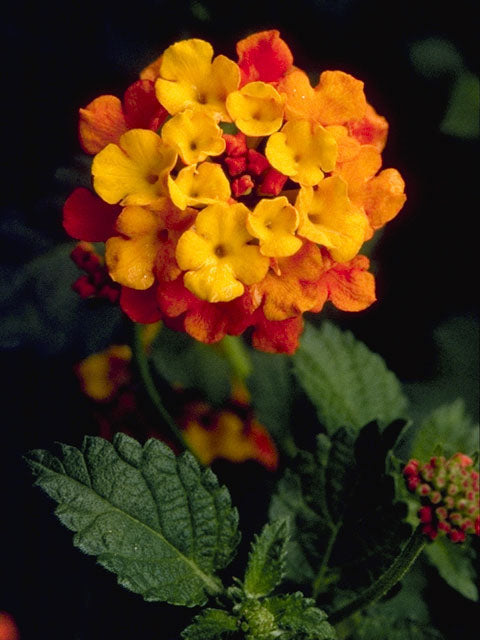Texas Lantana (Lantana urticoides)
Texas Lantana (Lantana urticoides)
Low stock: 10 left
Couldn't load pickup availability
Lantana urticoides Hayek
Texas Lantana, Calico Bush
Verbenaceae (Verbena Family)
Synonym(s): Lantana hispida, Lantana horrida, Lantana horrida var. latibracteata, Lantana notha, Lantana scorta, Lantana urticoides var. hispidula
USDA Symbol: LAUR2
A spreading shrub, much branched from the ground upward, branches sometimes with prickles. Frequent in brushy places and in woodlands. Bark light gray to light brown, tending to flake off. Young twigs nearly square in cross section, covered with short hairs visible under a 10x hand lens. Leaves opposite, up to 2 1/2 inches long, broadly ovate, pointed at the tip, flattened at the base, upper surface rough to the touch; margins coarsely toothed, teeth broad, pointed or rounded. Flowers colorful, red, orange, and yellow, tubular with four flared lobes; in dense, rounded clusters with a leafy bract subtending each flower, at the ends of long paired stems (peduncles) usually extending beyond the leaves, appearing from April to October. Fruit round, fleshy, dark blue to black.
This species is a member of the verbena family (family Verbenaceae), which includes about 75 genera and 3,000 species of herbs, shrubs, and trees, mostly of tropical and warm temperate regions. Among them, teak is a highly prized furniture wood, and Vervain, Lantana, Lippia or Frog Fruit, and Chaste Tree or Vitex are grown as ornamentals.
Plant Characteristics
Habit: Shrub
Leaf Arrangement: Opposite
Leaf Shape: Ovate
Fruit Type: Drupe
Size Notes: Up to about 6 feet tall, often shorter.
Fruit: Black
Bloom Time: Apr , May , Jun , Jul , Aug , Sep , Oct
Distribution
USA: AZ , NM , TXNative Distribution: East Texas west to southern Arizona, south to Oaxaca in southern Mexico
Native Habitat: Fields, thickets, swamps, rich sandy woods, scrub, gravelly hills, flats. Chaparral and roadsides, almost throughout Texas. Well-drained sand, loam, clay, caliche. Fields; thickets; sandy woods; gravelly hillsides
Growing Conditions
Water Use: LowLight Requirement: Sun
Soil Moisture: Dry
Heat Tolerant: yes
Soil Description: Poor, well-drained soils.
Conditions Comments: Lantana provides summer color. In winter, some gardeners prune back lantana to keep the plants from getting too large. The stems become thorny especially with age, so caution is necessary when cutting them back. The blue-black fruit clusters are poisonous. Used as a low to medium, flowering ground cover for dry, exposed, poor sites. Crinkly leaves give off a sharp aroma when touched and they can cause a skin rash. Mature plants tend to form large mounds that may be separated into smaller plants in the winter.
Benefit
Use Wildlife: Attracts butterflies. Deer-proof.Conspicuous Flowers: yes
Attracts: Birds , Butterflies
Nectar Source: yes
Deer Resistant: High
Propagation
Seed Collection: Collect seeds as soon as the fruit has filled out and turned dark. Air dry with pulp on or clean before storage. Store in sealed, refrigerated containers.https://www.wildflower.org/plants/result.php?id_plant=LAUR2
Image Information
Photographer: Seibold, GordonState: AL
Accession date: 1999-06-17
Filename: PCD3456_IMG0081.JPG
Slide Index: V3 95-154
Restrictions: Unrestricted
Collection: Wildflower Center Slide Library
Original Format: 35 MM
Orientation: Portrait
Shot: Flower(s)
Date Taken: 1995
NPIN Image Id: 7508


